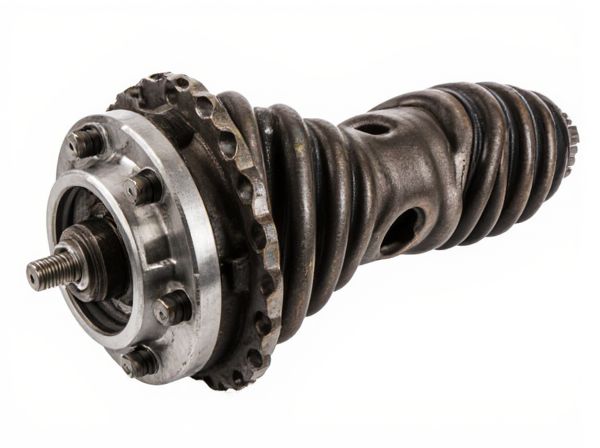
Photo illustration: Spool Differential vs Locker Differential
A spool differential locks both wheels on an axle together, forcing them to rotate at the same speed, which improves traction but can cause tire wear during turns. A locker differential actively locks and unlocks wheels as needed, providing enhanced traction without sacrificing maneuverability. Understanding these differences helps you choose the right setup for your vehicle's off-road or on-road performance needs.
Table of Comparison
| Feature | Spool Differential | Locker Differential |
|---|---|---|
| Function | Permanently locks both wheels on an axle, forcing them to spin at the same speed. | Locks and unlocks wheels automatically or manually to improve traction. |
| Traction | Provides maximum traction in all conditions by eliminating wheel slip. | Enhances traction selectively during off-road or low-traction situations. |
| On-road Handling | Can cause binding and tire wear during turns due to locked wheels. | Allows normal differentiation during regular driving, improving handling. |
| Installation | Simple installation, fewer moving parts, durable and low maintenance. | More complex installation with mechanical or electronic components. |
| Best Use | Ideal for dedicated off-road vehicles and rock crawlers. | Suitable for vehicles requiring on-road comfort and off-road capability. |
Introduction to Differential Systems
Differential systems play a crucial role in distributing torque between wheels, enhancing vehicle traction and handling. A spool differential rigidly connects both wheels, causing them to rotate at the same speed, which is ideal for off-road traction but can lead to tire wear on paved roads. Locker differentials, on the other hand, allow for selective locking, enabling wheels to rotate together during low-traction scenarios while permitting differential action at higher speeds for improved drivability.
What is a Spool Differential?
A spool differential replaces the traditional differential gears with a solid connector, locking both axle shafts together and forcing wheels to rotate at the same speed. This design enhances traction in off-road and racing applications by preventing wheel slip but sacrifices the ability to accommodate different wheel speeds during turns. Spool differentials are commonly used in drag racing and heavy-duty off-road vehicles where maximum power transfer to both wheels is critical.
What is a Locker Differential?
A locker differential is a drivetrain component designed to provide equal torque to both wheels on an axle, improving traction in off-road or slippery conditions. Unlike a spool differential, which permanently locks both wheels together, a locker allows for differentiation between wheels when needed but can be engaged to lock them for maximum grip. This mechanism enhances vehicle stability and performance in challenging terrains by preventing wheel slippage.
Key Differences Between Spool and Locker Differentials
A spool differential provides a solid connection between both wheels, eliminating wheel slip and improving traction during off-road conditions but sacrificing turning efficiency and causing increased tire wear. In contrast, a locker differential mechanically locks both wheels together, allowing for controlled engagement and better maneuverability on various terrains while offering improved durability and easier maintenance compared to spools. Key differences include the spool's permanent lock versus the locker's selective lock feature and the impact each has on vehicle handling and tire wear.
Advantages of Spool Differentials
Spool differentials offer superior durability and strength compared to locker differentials by providing a solid connection between the axle shafts, eliminating any slippage or differential action. This design enhances traction in off-road or high-torque situations, ensuring both wheels rotate at the same speed for maximum power transfer. Maintenance is minimal since there are no moving differential parts to wear out or fail under heavy loads.
Benefits of Locker Differentials
Locker differentials provide improved traction by mechanically locking both wheels on an axle to rotate at the same speed, enhancing off-road performance and preventing wheel slip in challenging terrains. Unlike spool differentials, which permanently lock the axle and can cause driveline binding and tire wear during turns, locker differentials engage only when needed, offering better handling and reduced tire wear on pavement. This targeted locking capability makes locker differentials ideal for vehicles requiring a balance between on-road drivability and off-road traction.
Drawbacks of Spool Differentials
Spool differentials provide a solid connection between both wheels, offering maximum traction but lack the ability to allow wheel speed differentiation, causing excessive tire wear and increased drivetrain stress during turns. This inability to compensate for different wheel speeds often leads to poor handling on paved surfaces and accelerated wear on suspension components. Unlike locker differentials, which can selectively lock and unlock to balance traction and maneuverability, spools sacrifice drivability for simplicity and strength.
Common Issues with Locker Differentials
Locker differentials often face common issues such as premature wear, binding during tight turns, and increased driveline vibrations due to their mechanical complexity. Unlike spool differentials that lock both wheels solidly, lockers can cause wheel hop and drivetrain damage if improperly maintained or aggressively used off-road. Regular inspection and lubrication are critical for locker differentials to prevent gear failure and ensure reliable cornering performance.
Ideal Applications: Spool vs Locker Differential
Spool differentials excel in drag racing and off-road racing due to their solid axle design providing equal power to both wheels, enhancing maximum traction on straight tracks. Locker differentials are ideal for off-roading and rock crawling because they automatically lock both wheels under low traction, allowing better maneuverability on uneven terrain. Selecting between spool and locker differentials depends on vehicle use, with spools suited for high-traction, straight-line performance and lockers preferred for variable traction conditions demanding wheel independence.
Choosing the Right Differential: Factors to Consider
Choosing the right differential depends on vehicle use, traction needs, and terrain type. Spool differentials provide maximum traction by locking both wheels, ideal for off-road and drag racing, but compromise on turning ease and tire wear. Locker differentials offer controlled locking with better maneuverability, suitable for mixed on-road and off-road driving, balancing traction and handling performance.
 caratoz.com
caratoz.com